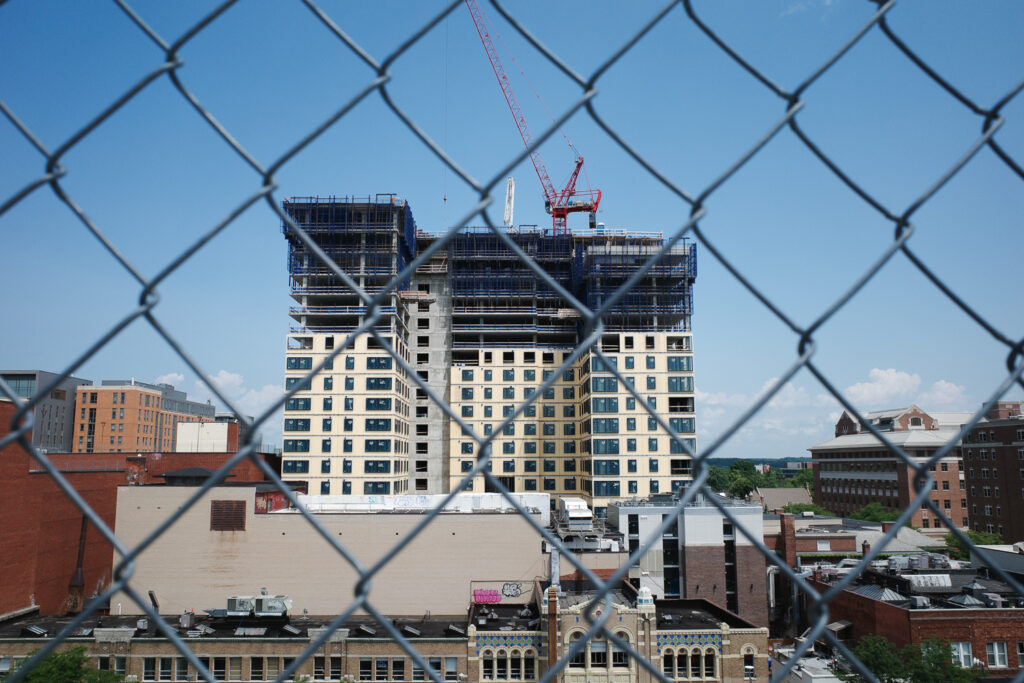Ann Arbor — This is no longer just a grimy college town filled with hippies, this is becoming a big city. The population is growing fast—so fast that there’s a major housing shortage. The university alone has added 10,000 new students in the least decade, increasing enrollment by 20%, and housing supply is nowhere close to keeping up. New housing simply must be built.
Over a dozen new high-rise apartment buildings are in the works. And students are complaining about it in the Michigan Daily, about how the high-rise apartments are “causing Ann Arbor to lose its college-town charm” and how the new developments aren’t worth it, as the “increased presence of high-rises in Ann Arbor also drives up the housing prices of nearby residences.” This is because the rents are based on “whatever the market allows,” according to the South Korean international student who authored the piece. Welcome to America, child.
I’ll be the lone contrarian among the cultural vanguard. High-rises are an important part of solving Ann Arbor’s housing problem. They could even contribute to campus culture in a cool way if developers were willing to be bold.
In all honesty, I wanted to write a piece complaining about the new high-rises too. They’re too new, too shiny, too rich. They’re everything I opposed as a student. I lived in a filthy off-campus house with six of my buddies, not some luxury condo. Our home had permanently sticky floors, ratty carpeting, and a dinner table perpetually used for beer pong, not fine dining. We did whatever we wanted: smoked weed in the house, poured our cooking oil down the sink. When we finally moved out, we left it a train wreck, with a pile of trash 10-feet high in the driveway, and we still got our deposit back. Someone even caused a dumpster fire on move-out day—wasn’t us, I promise, but it’s a fitting metaphor for how the off-campus student ghetto usually functions.
I knew people who lived in the high-rises. There were only two of them when I was in school 10 years ago. The first to go up, Zaragon (now called “Z Place”), was a palace. The top-floor penthouses are two stories tall, with hanging walkways across their spans and glass all the way to the ceiling. Fraternities rented them and used them as junior/senior houses to throw parties at. These penthouses were baller. They felt like something out of Entourage.
They were everything that’s easy to loathe and easy to envy, if you didn’t live there yourself. Exclusive, scarce, luxurious, hierarchical. Pads for a niche class of the university elite, the rich and connected kids who liked to have too much fun. But if you ended up at one for a pre-game, before going to Ann Arbor nightclub Rick’s, in the basement, you legitimately felt cool as hell. Ironically, Zaragon has been eclipsed by the dozen or so new and taller buildings.
A second high-rise popped up during my tenure. Landmark, a much larger, more cheaply made building. Cheaply made in the sense that you could hear everything, and I mean everything, through the paper-thin walls (don’t ask me how I know this). There are penthouses on top too, but not nearly as cool as Zaragon’s, nor as exclusive.
The one I chilled at was rented by a group of rich Indian guys, fully decked out with neon lights, pong tables, and even a custom dab rig they sat around getting high all day. Let’s face it though, this wasn’t the elite U-M penthouse. They couldn’t touch the Zaragon frat boys. Landmark was a lesser brand from the start, auspices of luxury, while feeling like a giant dorm.
At any rate, the flood of high-rises started then, and demand has only increased since. Every time I’m back in Ann Arbor, a new one is sprouting up, towering edifices of brick facade and glass. What started as a luxury is now a normal way of life for a significant proportion of the student body.
This is the trend and model for all the new high-rises. Supply and demand—the more that pop up, the less exclusive and luxurious each one feels. As student housing gets better and more abundant, it feels less special, and we romanticize the dingy past. Ironically, this points us to the real problem—the dingy past was cool in ways the high-rise future hasn’t matched or even tried to envision.
The new high-rises aren’t cool enough to enact any meaningful change. They’re commie blocks, one step up from dorms. Zaragon in its heyday profoundly shifted campus culture, throwing a wrench into the previous housing hierarchy of dorms, off-campus houses, and greek life. There was now a higher tier, accessible only to a very few. It changed things, and, though many hated it, it was cool.
In essence, the new high-rises aren’t all that different from the dorms. They’re just nicer, more expensive, and outside the yoke of the university housing system, with its arbitrary rules (no smoking or drinking in the dorms, kids) and petulant RAs. The university has poured millions into updating its dorms too—my old dorm building, South Quad, with its shower stalls, communal bathrooms, and cramped double rooms, was totally gutted and revamped a few years after I left. Students are no longer forced to shower while listening to their roommate puke up last night’s beers in the next stall over. Student housing across the board is a major commodity, and standards are getting higher.
You can’t have your cake and eat it, too. Students need somewhere to live. Sure, we all wish rent was more affordable. Increasing housing supply is the only way to solve that, and new high-rises are part of that solution. The cookie-cutter buildings might be cultural dead zones, but they don’t need to be; this is where the solution comes in, one everyone could be happy with, or at least find cause for envy, instead of scorn.
What Ann Arbor needs to save campus culture and fix the housing shortage are more buildings like Zaragon. More exclusive than the mega high-rises, with distinctive aesthetics, that contribute to the culture by hosting social spaces, bars and clubs and restaurants and such, on their ground floors. Outdoor communal spaces, places for social dynamics to emerge. Penthouses, large sprawling dwellings, places to make memories, not to sit in your room and scroll on your phone.
New housing has to contribute to the longstanding uniqueness of the campus. The model for Ann Arbor has always been the dingy off-campus dwellings, the frat houses straight out of Animal House, and the model for high-rise culture should mirror that.
New high-rises, at their worst, can become expensive, solipsistic closets that students rarely need to leave. Entice the youth with something different, something that promises social capital, clout, and even a good time, and not only will you solve the housing crisis, but you’ll keep Ann Arbor cool for decades.
Bobby Mars is an artist, alter ego, and former art professor. Follow him on X at @bobby_on_mars.



